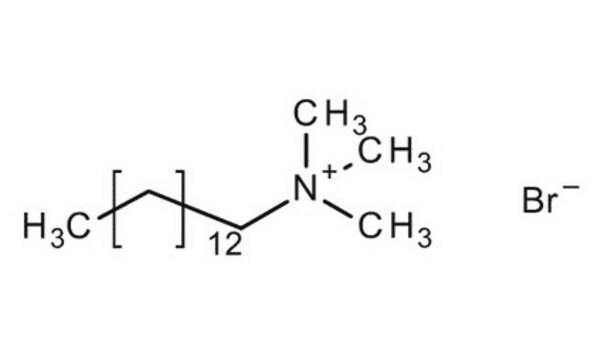87210
Myristyltrimethylammonium bromide
98% (AT)
Synonym(s):
Tetradecyltrimethylammonium bromide, Trimethyl(tetradecyl)ammonium bromide
About This Item
Recommended Products
description
cationic
Quality Level
Assay
≥97.5% (AT)
98% (AT)
form
crystals
mol wt
micellar avg mol wt 27,000
aggregation number
80
CMC
4-5 mM (20-25°C)
mp
245-250 °C (lit.)
solubility
H2O: 0.1 g/mL, clear
SMILES string
[Br-].CCCCCCCCCCCCCC[N+](C)(C)C
InChI
1S/C17H38N.BrH/c1-5-6-7-8-9-10-11-12-13-14-15-16-17-18(2,3)4;/h5-17H2,1-4H3;1H/q+1;/p-1
InChI key
CXRFDZFCGOPDTD-UHFFFAOYSA-M
Looking for similar products? Visit Product Comparison Guide
General description
Application
- Enhance the biomass harvesting and pigments extraction from the cyanobacterium Synechocystis sp. PCC 6803.
- Facilitate the formation of mixed micelles with amitriptyline hydrochloride.
Signal Word
Danger
Hazard Statements
Precautionary Statements
Hazard Classifications
Acute Tox. 4 Oral - Aquatic Acute 1 - Aquatic Chronic 1 - Eye Dam. 1 - Skin Irrit. 2 - STOT RE 2 Oral - STOT SE 3
Target Organs
Gastrointestinal tract, Respiratory system
Storage Class Code
11 - Combustible Solids
WGK
WGK 3
Flash Point(F)
Not applicable
Flash Point(C)
Not applicable
Personal Protective Equipment
Choose from one of the most recent versions:
Already Own This Product?
Find documentation for the products that you have recently purchased in the Document Library.
Customers Also Viewed
Our team of scientists has experience in all areas of research including Life Science, Material Science, Chemical Synthesis, Chromatography, Analytical and many others.
Contact Technical Service














